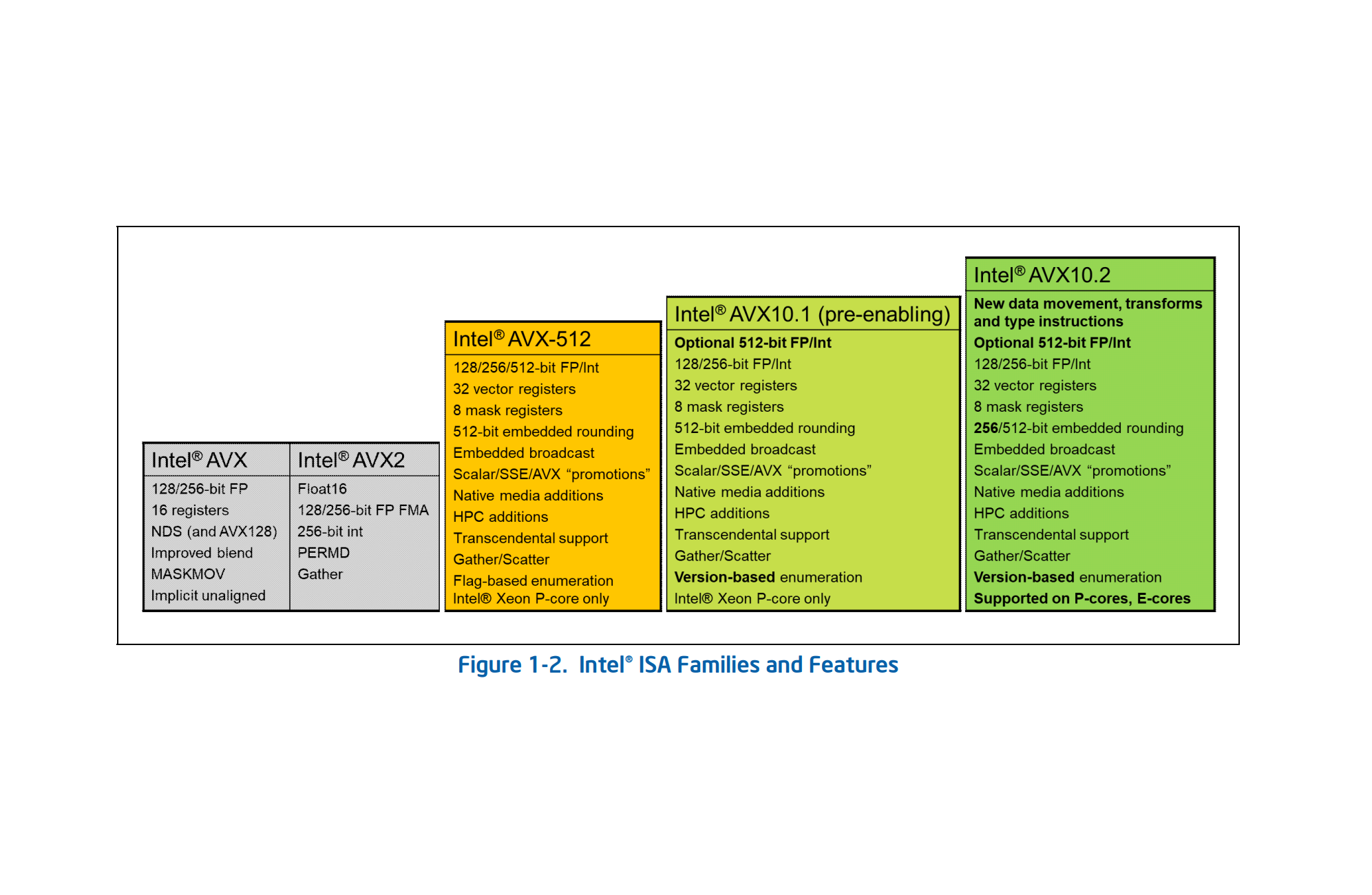Intel's Clear Linux distribution adds support for APX and AVX10, which aren't out yet
Advanced Performance Extensions (APX) and Advanced Vector Extensions 10 (AVX10) are seemingly being added for future CPU support

Intel's previously-announced Advanced Vector Extensions 10 (AVX10) and Advanced Performance Extensions (APX) are now making their way to Intel's own "Clear Linux" distro, according to a report from Phoronix. Clear Linux is aimed at Linux developers who want the highest degree of Intel hardware optimizations under an optimized Linux environment, and is maintained in-house at Intel. Interested users can snag it from the main Clear Linux site, though this is not a distribution intended for mainstream usage.
According to Phoronix, proper implementation of AVX10.1 won't be seen until the launch of Granite Rapids later this year, where they speculate that APX may also come with the new CPUs (though this is still unconfirmed). The two features being initially presented side-by-side and added into Clear Linux simultaneously with this update suggest this is a possibility, though.
Patching in support this far ahead of release should mean that Intel will have plenty of time to test the new hardware under Clear Linux before end users and professionals need to start relying on it as a daily driver. As long as Intel does its due diligence, this bodes well for the next generation of Intel hardware under Linux— which is already faring surprisingly well with the recent release of Meteor Lake, particularly on the iGPU side of things.
According to the original Clear Linux Community Forum post made three days ago, this update will offer APX and AVX10 in a bundle of compiled software, and surface in releases "later this week." In the future, this implementation of AVX10 will allow AVX-512 applications to run across both Intel's P-Cores and E-Cores, among other improvements. This should lead to some considerable improvements on Intel CPUs that adopt the new hybrid design.
Intel APX, meanwhile, doubles general-purpose registers from 16 to 32 and allows APX-compiled code to run with 10% fewer loads and 20% fewer stores than Intel 64's baseline. This will mainly serve to improve efficiency, and can also serve as a method of boosting AI performance, according to Intel's documentation.
Get Tom's Hardware's best news and in-depth reviews, straight to your inbox.

Christopher Harper has been a successful freelance tech writer specializing in PC hardware and gaming since 2015, and ghostwrote for various B2B clients in High School before that. Outside of work, Christopher is best known to friends and rivals as an active competitive player in various eSports (particularly fighting games and arena shooters) and a purveyor of music ranging from Jimi Hendrix to Killer Mike to the Sonic Adventure 2 soundtrack.
-
bit_user This is a nothing burger. AVX10.1 adds no practical benefits over AVX-512, at the level Granite Rapids will support the latter.Reply
Furthermore, Intel hasn't announced APX support in any CPU set to launch this year. I think the APX aspect is probably just so that Intel can start doing internal testing, profiling, & tuning so that compiler support for APX is in good shape, by the time supporting silicon finally does launch. -
bit_user ReplyIn the future, this implementation of AVX10 will allow AVX-512 applications to run across both Intel's P-Cores and E-Cores, among other improvements.
No, it won't.
AVX10 will enable client CPUs to use AVX-512 features and semantics, but only at up to 256-bit widths. Their docs refer to this as AVX10/256.
Intel APX, meanwhile, ... can also serve as a method of boosting AI performance, according to Intel's documentation.
No, it doesn't.
You read that too quickly. The only place the linked document mentions AI performance is in reference to AMX, which is completely different and unrelated.
Contrary to all these vector & matrix extensions, the interesting thing about APX is that it should improve performance on general-purpose computation!
C'mon, guys. I know this stuff is complex, but these details actually matter! -
Amdlova Great intel will have avx512 again on desktop cpus with avx10.2 version. Two year for now or more...Reply
Maybe with these new anti 32bits cpus.
Sad -
bit_user Reply
Nothing of the sort has been announced. AVX10.2 does not imply 512-bit.Amdlova said:Great intel will have avx512 again on desktop cpus with avx10.2 version. Two year for now or more...
I'm not saying 512-bit will never return to Intel's client CPUs, but the first thing we should see in them is AVX10/256. -
thestryker Reply
This is definitely right (10.2 is AVX10/256 for client) and I'd be surprised if that changed any time soon.bit_user said:Nothing of the sort has been announced. AVX10.2 does not imply 512-bit.
I'm not saying 512-bit will never return to Intel's client CPUs, but the first thing we should see in them is AVX10/256.
I'd bet that's the same reasoning for AVX10 as well as I'm sure Intel wants to make recompiling to 256 as painless as possible. They seem to do an awful lot of really good customization work with Clear so it makes sense to me that they'd get everything in as early as possible.bit_user said:I think the APX aspect is probably just so that Intel can start doing internal testing, profiling, & tuning so that compiler support for APX is in good shape, by the time supporting silicon finally does launch.
Perhaps for E-cores Intel will eventually go the route AMD has for AVX512 implementation as it seems to be the most efficient way to go about it. I'm just not sure it'll be worth the die space unless there are calls for it from their high core count customers.